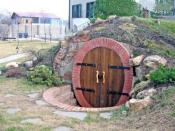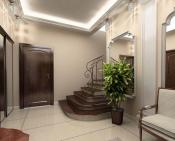Search
Login
Recommended
Growing in a greenhouse, how the greenhouse differs from a greenhouse, types of greenhouses, a greenhouse on a site with their own hands
Having taken up the cultivation of vegetables in a country house or in a suburban area, beginning vegetable growers quickly become convinced of the need to build greenhouses or greenhouses. These two structures are quite similar, however, there is a difference between them. Although the problem that is solved with their help is the same: bringing plant yields to the optimum level, subject to cultivation in adverse climatic conditions.
Content:
- Greenhouses and greenhouses, what is the difference that came before
- Types of greenhouses, how they are used
- Greenhouse design features video
- How to build a greenhouse video
- What to plant in a greenhouse in spring
- Organization of watering in greenhouses
- Greenhouse in autumn and winter - how to use video
Greenhouses and greenhouses, what is the difference that came before
Initially, greenhouses began to be used by vegetable growers to protect plants, they are simpler structures, a small air volume in such structures allows heating naturally: during the day they are sufficiently heated by the sun's rays, at night the source of heat is burning manure, they usually fill a hole dug under in a greenhouse.

The traditional greenhouse had a height of less than half a meter; glazed frames were used to cover from above.
In the quality of the prototype of the greenhouse can be called once popular greenhouses used for breeding exotic southern plants. Mention of heated greenhouses dates back to the 16th century. At the end of time, greenhouses were replaced by greenhouses, they were built from strong metal frames and glass. These were expensive, very bulky and heavy buildings.
The truly rapidly developing greenhouse economy began with the advent of plastic films. They, with their low weight, made it possible to significantly lighten the frame, simplify the installation process, while not losing strength and heat-saving characteristics. Today, in the construction of greenhouses, even lighter and more durable modern materials are used, such as polycarbonate and spanboard.

Let's clarify what can be called a greenhouse:
- the height of the structure should not exceed 1.3 m
- type of heating - natural, due to the sun and energy received from decaying humus or manure
- lack of a door, access to plants provides a removable upper or side frame
Types of greenhouses, how they are used
Structurally, greenhouses can differ from each other, moreover, they can be both stationary and portable, but the purpose for which the greenhouse is usually used is seedlings, i.e. it sows seeds and grows plants until they can be planted in open ground.
A portable greenhouse can be used as a temporary shelter for freshly planted seedlings or, in case of severe cooling, to protect heat-loving plants.

A portable greenhouse will be able to protect plants from not severe frosts.
The operation of greenhouses requires constant monitoring of temperature and humidity, i.e. in any case, the organization of high-quality ventilation and ventilation will be required. Raising the temperature and humidity above the norm is not recommended, the threat of active reproduction of pathogenic microbes is quite likely.
How to build a greenhouse
To build a greenhouse on the site, a significant amount of materials will be required, the installation process itself will take a lot of time. For those summer residents who plan to grow vegetables not for sale, but only to provide their family with the best option, is to build a greenhouse, it will be possible to grow greens and seedlings of tomatoes, peppers, and eggplant.

You can build a greenhouse in the spring in a few hours, but you should choose a place for it and carry out preparatory work since the fall.
Choose a location should be on a hill, with the expectation that melt water could not flood it. A small pit is digging under the greenhouse, with a depth of not more than 0.7 m. The width is calculated taking into account the parameters of the material that will be used to construct the frames, the most convenient option is when the width of the greenhouse is equal to the size of the tightened film or glazed frame.

Digging out the pit, you will need to fill it half the depth with manure, compost, plant debris, and straw. Then a layer of soil is filled up, humus and mineral fertilizers should be added to it according to the norms.
Greenhouse design features
When designing a greenhouse, it is recommended to choose a frame design that is easy to remove at all or lift. If the frames rise, then to fix them you will need to prepare wooden blocks.
If the frames will be removed, then next to the greenhouses it is recommended to build a stand for storing the removed frames. It can be several pairs of wooden stakes driven into the ground in parallel rows. The height of the stakes is determined by the width of the frame, they should be slightly higher. To connect the stakes using bars, they are attached to the upper and lower parts of the structure. To build a stand is not difficult, but it will prevent the possibility of falling frames and their damage.
By design, greenhouses can differ significantly from each other.
The most simple, unpaved, is a section covered by a film. Of course, the cost of its construction will be minimal, it is suitable for growing herbs, lettuce, onions and radishes, seedlings, i.e. undersized crops. Due to some inconvenience to care, the recommended width of this design is a maximum of 30 cm.

Among the advantages of the design can be noted the cheapness, among the disadvantages: inefficient use of lighting, space and the complexity of care.
To some extent, eliminate the disadvantages will help used as a covering material agrofilm.
A more perfect construction greenhouse is a warm pit. It is possible to grow different undersized cultures in this. A shelter of such a greenhouse can be a film or frame with glass or polycarbonate. Among the shortcomings, a high level of heat loss should be noted.

In the old days, as a rule, they built a complex of three or four frames, charging them with fuel in turn, they got the opportunity to grow different types of greenery throughout the year, while one of the pits was warming up, others actively harvested. A prerequisite for the successful operation of such a complex is the construction of a clay castle with a drainage ditch. Its absence leads to acidification of the biofuel used.

Optimal from the point of view of simplicity of design, ease of use and energy saving is a film greenhouse on a prefabricated frame, for example, Snowdrop. A large volume of air inside the structure provides a high level of the greenhouse effect, which allows you to install the structure immediately after the snow cover has melted.
The design does not limit the size of crops grown, i.e. if desired, even cucumbers can be grown in it. If necessary, the greenhouse is easily transported and quickly installed in a new place. It is not difficult to find a scheme for creating this type of greenhouse on your own, only at first it is recommended to calculate the cost of purchasing the materials and fasteners that you will need when assembling with your own hands, it is possible - the finished construction will be cheaper.

We should not forget that the full effectiveness of the greenhouse will manifest itself only if it is covered with agrofilm.
Cassette greenhouse-box can be used exclusively for growing seedlings, it can be soil or bulk. The optimum life of the soil in it is from 1 to 3 months, during this period the soil is completely depleted. Such a greenhouse is being constructed from covering material, agrofibre, this allows to optimize the use of light.

When creating ideal conditions, such a greenhouse-cassette allows you to grow the amount of seedlings required for planting on 12 acres of open ground.
A butterfly greenhouse, or a house, is usually used as a moving structure, in most cases for growing eggplant, tomatoes, and pepper. The main disadvantage is that the film is not stretched on the frame and when performing constant ventilation procedures quickly becomes unusable.
For the construction of bulk greenhouses, strong frames are used, more often - wooden frames, either a plastic film or agrofibre is used as a coating.
What to plant in a greenhouse in spring
Usually this question does not arise, because the traditional purpose of the greenhouse in the country is to grow greens and seedlings of tomatoes, peppers, eggplant, flowers.

Preparing a greenhouse for spring is the following:
- with the onset of March, but if the winter is warm, then it is possible in the third decade of February, you will need to prepare a frame, glazed, tightened with a covering material or film
- the frame is installed on the frame, check the tightness of its fit, the slope of the frame should be towards the south, so the soil will warm up much faster
- when the weather allows planting or sowing seeds - the greenhouse is ventilated and the soil is abundantly poured in it with well-heated water
- to prevent the development of pathogens and fungi, it is recommended to treat the soil with fungicides, in strict accordance with the instructions for their use
To prevent the burning of tender leaves, experts recommend covering the greenhouse with covering material, and on top of it a glass frame. This will protect the plants from excessive heat and combustion from sunlight.
As the advantages of the greenhouse, it is worth noting the possibility of obtaining excellent, strong seedlings, with a high-quality root system, without the unnecessary hassle associated with the use of peat cups. Also, you do not need to clutter the window sills in the house with drawers with seedlings.

Unheated greenhouses are also used for hardening seedlings grown indoors. Before planting in open ground, this is very important, it is much easier for a hardened plant to adapt to temperature extremes.
Take out boxes with seedlings in the greenhouse after preparing the beds for planting these crops. The first days of the frame are removed only for a day, then left ajar for the night, after a week the frames are removed completely. For the process of hardening seedlings, it will take about 10-12 days. Further, seedlings can be planted in open ground.
Organization of watering in greenhouses
An obligatory moment of caring for a greenhouse in the spring is watering seedlings. In this case, you will need to either remove the frames, or open them. Given the need for daily care, it is undeniable that a polycarbonate greenhouse with an opening frame would be an ideal option.
Watering the seedlings follows from a watering can, in extreme cases, you can use a hose equipped with a sprayer, when watering, you must not allow the soil to erode around the roots. If possible, it is recommended to build a drip irrigation system, because it allows you to organize a regular flow of moisture to the roots.

During the spring operation of greenhouses, it is necessary to monitor the purity of the material with which the frames are tightened. Strong pollution of them will lead to the fact that seedlings will begin to experience a deficit of light.
If the greenhouse is not used in summer, the frames should be completely removed. Rain water in this case will be able to wash the soil from the accumulated excess of mineral salts.
Greenhouse in autumn and winter - how to use
Hobby gardeners often use greenhouses to store plants. These may be cultures that are undesirable to be exposed to low temperatures. For example, chrysanthemums are often stored in this way, bushes are transplanted into boxes, the stems are cut to a height of 15 cm, and set in an unheated greenhouse.
In the same conditions, bulbs and tubers of garden plants that do not tolerate frost and need protection will be well stored. They are stored in boxes covered with dry peat. To ensure good preservation of the bulbs of plants placed at a certain distance from each other, this will allow air to circulate.

If we talk about what to plant in a greenhouse in the fall, then we should recall the forcing of bulbous plants. They are planted in beds for growing seedlings to provide protection from the cold - they are covered with a thick layer of peat, about 10 cm. In this case, it will be necessary to provide ventilation of the greenhouse, i.e. covering frames tightly is not recommended.
In the absence of ventilation, at positive temperatures, gray rot can develop under the frames, of course, it cannot be allowed to appear.
During the wintering period, the bulbs form a dense root system, with the onset of spring heat - very quickly they will give green feathers of good quality.
If storage and distillation is organized in greenhouses of bulbs for planting in open ground, for example, flower crops, then bulbs are placed in pots with a nutritious mixture, installed in a greenhouse and covered with a thick layer of peat. With the termination of spring frosts, rooted bulbs can be planted in open ground.

If greenhouses are not used in the winter, then it is recommended to remove the frames, and fill the soil with a thick layer of snow.
And another interesting and useful video about the construction of greenhouses on the site:





